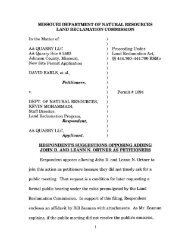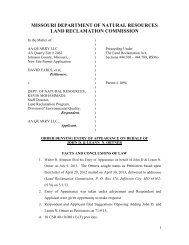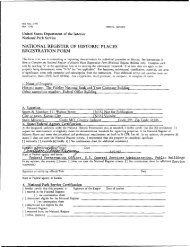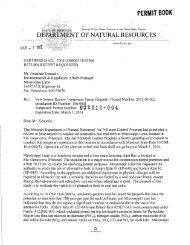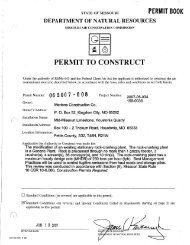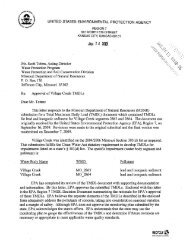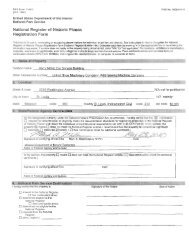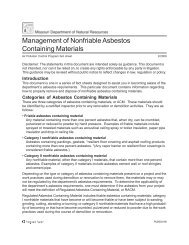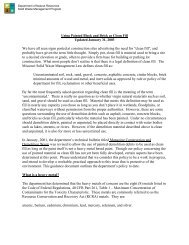Winter 2006 - Missouri Department of Natural Resources
Winter 2006 - Missouri Department of Natural Resources
Winter 2006 - Missouri Department of Natural Resources
You also want an ePaper? Increase the reach of your titles
YUMPU automatically turns print PDFs into web optimized ePapers that Google loves.
ceptable. <strong>Department</strong> representatives<br />
also routinely make on-site inspections.<br />
If systems continue to fail to comply<br />
with <strong>Missouri</strong>’s drinking water law, more<br />
stringent enforcement action may be<br />
pursued through legal channels.<br />
To view more details on the violators<br />
listed, visit [www.dnr.mo.gov/env/wpp/<br />
chronic/3Qchronic.pdf].<br />
These and other violations are<br />
detailed in the department’s Annual<br />
Compliance Report <strong>of</strong> <strong>Missouri</strong> Public<br />
Drinking Water Systems. A copy may<br />
be obtained by calling the department’s<br />
Water Protection Program at 1-800-361-<br />
4827 or (573) 751-5331 or the report<br />
can be downloaded at<br />
[www.dnr.mo.gov/env/<br />
wpp/fyreports/index.html].<br />
Compliance Assistance<br />
Before Inspection<br />
The <strong>Department</strong> <strong>of</strong> <strong>Natural</strong><br />
<strong>Resources</strong> has launched a new compliance<br />
assistance initiative to assist citizens,<br />
communities and businesses that<br />
obtain permits, licenses, certifications<br />
and registrations from the department<br />
and to encourage compliance with<br />
<strong>Missouri</strong>’s environmental laws.<br />
In the first phase <strong>of</strong> the new initiative,<br />
the department will visit land disturbance<br />
sites, newly permitted air pollution<br />
sources, drinking water facilities<br />
where permit actions are anticipated,<br />
limestone quarries and hazardous<br />
waste generators. The department will<br />
guide permit holders through their<br />
unique permit requirements and provide<br />
compliance assistance rather than<br />
conduct formal inspections.<br />
Working on compliance up front is<br />
more beneficial for everyone, according<br />
to <strong>Department</strong> Director Doyle Childers.<br />
“First and foremost, it protects the environment<br />
because it’s preventative<br />
rather than an after-the-fact cleanup,”<br />
he said. “This saves time and effort for<br />
citizens, communities and businesses<br />
while our air, land and water resources<br />
are being protected.”<br />
The department conducted about<br />
250 assistance visits in November. The<br />
experiences from this startup phase<br />
were reviewed, and changes will be<br />
Reservoir Failure Floods State Park<br />
In the early morning hours <strong>of</strong> Dec. 14, the AmerenUE Taum Sauk hydroelectric<br />
plant’s upper reservoir near Lesterville breached, flooding Johnson’s<br />
Shut-Ins State Park with approximately 1.3 billion gallons <strong>of</strong> water.<br />
The state holds AmerenUE responsible for the incident and any subsequent<br />
damage and cleanup, and will require AmerenUE to pay for and reimburse<br />
the state for any expenses, including <strong>Missouri</strong> <strong>Department</strong> <strong>of</strong> <strong>Natural</strong><br />
<strong>Resources</strong> oversight and assistance. Gov. Matt Blunt directed the use <strong>of</strong> the<br />
department’s emergency funds to cover the state’s interim costs to restore<br />
and stabilize the flood area until AmerenUE can reimburse the state.<br />
Environmental stabilization and water quality impacts to the Black River<br />
were the state’s immediate concerns.<br />
“The governor has instructed us to expedite our efforts to restore the natural<br />
and cultural resources <strong>of</strong> Johnson’s Shut-Ins State Park and the Black<br />
River,” said <strong>Department</strong> Director Doyle Childers. “We are committed to having<br />
some services available at the park by this summer. But, we don’t want<br />
to go so fast that we negatively impact the future <strong>of</strong> the park.”<br />
The state <strong>of</strong> <strong>Missouri</strong> remains involved in the oversight <strong>of</strong> recovery<br />
efforts. Since the incident occurred, the department’s Environmental<br />
Emergency Response team has been on site, coordinating the response to<br />
the reservoir failure. Staff from the department’s State Parks and Geology<br />
and Land Survey divisions, as well as the <strong>Missouri</strong> <strong>Department</strong> <strong>of</strong><br />
Conservation, are working on a natural resource damage assessment to the<br />
area. The department’s Division <strong>of</strong> Environmental Quality also provided<br />
assistance for the incident.<br />
Preliminary reports indicate the majority <strong>of</strong> the damage was in the area<br />
adjacent to the East Fork <strong>of</strong> the Black River, which flows through Johnson’s<br />
Shut-Ins State Park. The park superintendent’s residence, the campground,<br />
and the park’s water plant were destroyed and significant damage was done<br />
to other smaller buildings, a section <strong>of</strong> the Ozark Trail, and the boardwalk to<br />
the shut-ins — the park’s signature natural feature. The park store and <strong>of</strong>fice<br />
were flooded but are still standing. The park remains closed until services<br />
can be restored and it is safe to reopen to the public.<br />
People interested in the status <strong>of</strong> the state park are urged to visit the<br />
department’s Web site at [www.mostateparks.com]. Updates will be posted<br />
on the Web site and through the other media.<br />
DNR photo by David Kelly<br />
<strong>Winter</strong> <strong>2006</strong> 17



